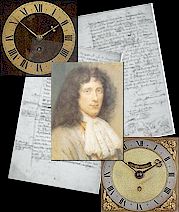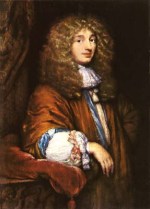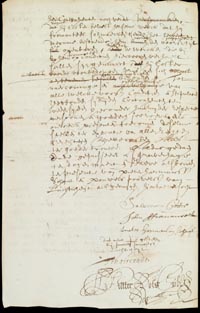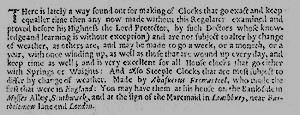Compilation of the
COSTER-FROMANTEEL
Notarial Act.

Compiled by: Fred Kats.
Table of contents:
Introduction.
The
Notarial Act (links to transcripts and translations).
Contract summary.
About Coster
and Fromanteel.
Who
promised to disclose a secret.
Daags
dienvolgend' versus 'Soo is dienvolgens.
The
translation of 'volmaecken'.
About
the
Piggott paper.
Acknowledgments.
Footnotes.
Links:
Source document,
P1.
P2.
Chr.
Huygens' Œuvres Complètes.
(pdf)
Chr.
Huygens Horologium 1658.
(pdf)
26
The
Piggott paper.
Speculations
on the historical backgrounds of the contract.
"I am aware of the fact that we will never be absolutely certain about
the incentives of the
visit by Coster and Fromanteel to Mr. de Putter's
(notarial)
office." Frits van Kersen.
"The
historic Contract, between Salomon Coster and John Fromanteel, remains
curious and by no means understood, but is only one of the many
unresolved enigmas in the history of European horology."
Keith Piggott.
 INTRODUCTION
INTRODUCTION
It is commonly believed that Christiaan Huygens was
the first to combine a
pendulum with a verge clock in 1656. In June 1657 he had a pendulum clock
most likely made by Salomon Coster and
patented in the United Provinces (the Netherlands),
and it was published in his 'Horologium' in 1658.

Fig. 1 (click for more)
Christian Huygens. 1629-1695
The improvement was so dramatic that
other clockmakers followed suit. It is assumed that Huygens permitted Salomon Coster to
provide training on pendulum clocks to foreign clockmakers, one
of them was John Fromanteel son of Ahasuerus
a London clockmaker of repute.
This compilation is about the Notarial Act (contract)
between Coster and Fromanteel (Sept. 1657) which, as commonly
understood, enabled Fromanteel
to learn about Huygens' new and famous pendulum clocks.
 THE
CONTRACT THE
CONTRACT

Fig. 1a (click to enlarge)
Coster-Fromanteel contract
,
facsimile of the first page.
(view
high resolution version)
© Municipal
Archives, The Hague.

Fig. 1b (click to enlarge)
Coster-Fromanteel contract
,
facsimile of the second page.
(view
high resolution version)
© Municipal
Archives, The Hague.
 CONTRACT SUMMARY
CONTRACT SUMMARY
|
John Fromanteel was:
|
|
● |
to work for Salomon Coster from
September 3rd 1657 until May 1st 1658. |
|
● |
to make clocks, as he did
before, either in the shop
or in the house of Coster’s. |
|
● |
already a capable clockmaker. |
|
|
Salomon Coster was:
|
|
● |
to pay 20 caroli guilders15.
for each clock made by Fromanteel. |
|
● |
to pay 18-10-0 caroli guilders
for each clock made by Fromanteel if Coster supplies the
brass and steel. |
|
● |
to pay for Fromanteel's heat, light
and beer during this period of time. |
|
● |
to disclose, before May 1st 1658,
the secret
16
existing in the clocks made by Fromanteel, provided that the
clocks made by Fromanteel will remain at Coster’s. |
 ABOUT COSTER AND FROMANTEEL
ABOUT COSTER AND FROMANTEEL
Salomon
Coster, ante 1623 - 1659.
Salomon was born in Haarlem in the United Provinces (the Netherlands)
before 1623 and moved to The Hague shortly after his marriage in 1643.
Like several Haarlem clockmakers, he was a Baptist. In 1646 Pieter Visbagh
was apprenticed to him for six years, and in 1657 Christiaan Reijnaert
for ten years. In the same year Christiaan Huygens allowed him ('met
privilege') to make and sell pendulum clocks. In this year John Fromanteel
came from London and worked with Coster, followed by Nicolas Hanet from
Paris in 1658. Salomon Coster died suddenly in December of 1659 and
the following year the shop was taken over from Coster’s widow by Pieter
Visbagh.
2
End
John Fromanteel, 1638 - ante 1692.
John was apprenticed to his father in 1652. Part of his apprenticeship
was spent in the Hague with Salomon Coster where he was trained to make
pendulum clocks. After he brought the new skills back to London in 1658,
the Fromanteel family made the first English clocks, using a verge and a short
pendulum. He became a Freeman of the Clockmakers’ Company in 1663. He
took four apprentices between 1663 and 1679, one of whom was his son
Ahasuerus III. He appears to have worked in the family business until
about 1680 when he went to Holland with Ahasuerus II to pursue the family
clock making business there and may well have died there before his
father’s will was made in 1692.
4

Fig. 2 (click to enlarge)
Facsimile of Ahasuerus Fromanteel's advertisement in "Mercurius Politicus"
October 1658.
 End
of this section, click here to continue.
End
of this section, click here to continue.

Footnotes & Further reading.
1.
Municipal Archives, The Hague, Notarial Archive.
Beheers №372, Inventaris №322, Folio 409 & 409 verso.
2.
Dr. R.
Plomp, Spring driven Dutch pendulum clocks 1657-1710.
(Schiedam: Interbook International B.V., 1979)
3. R. D. Dobson.
‘Huygens. the Secret in the Coster-Fromanteel Contract, the
Thirty-Hour C1ock, in: Antiquarian Horology. Vol. 12. No. 2.
Summer 1980. P. 193-196.
4.
Hans van den Ende, Dr Frits van Kersen, Maria F. van Kersen-Halbertsma,
Dr John C. Taylor and Neil R. Taylor, Huygens’ Legacy, catalogue of
an exhibition held at Paleis Het Loo, (Castletown, Isle of Man: Fromanteel
Ltd, 2004), 5.
Chr. Huygens, Œuvres Complètes de Christiaan Huygens,
(The Hague: M. Nijhofl’, 1888-1950), Vol.17, pp.21-22.
(go
to)
5a Chr.
Huygens, Œuvres Complètes de Christiaan Huygens, (The Hague: M.
Nijhofl’, 1888-1950), 2 no. 565.
6.
E.L. Edwardes, the suspended Foliot and new Lights
on early Pendulum Clocks’, Antiquarian Horology, 12/6, June, 1981.
7.
E.L. Edwardes and R. D. Dobson, ‘The Fromanteels and the Pendulum Clock’,
Antiquarian Horology, 14/3, September, 1983.
8. R. D. Dobson, † 2005. De slinger als
tijdmeter. Een nieuwe visie op de ontwikkeling van de
slinger als tijdmeter in de periode van 1602-1660. Galileo
Galilei- Ahasuerus Fromanteel - Christiaan Huygens.
Achterland Verlagscompagnie. Bocholt Bredevoort/Uitgeverij
Fagus, Aalten. p.41.
9. E.L. Edwardes, The Story of the Pendulum
(‘lock, (Altrincham, John Shcrrart & Son Ltd., 1977),
p.58-59
10, Frits van
Kersen, ‘The Coster-Fromanteel Contract Re-examined’,
Antiquarian Horology,
28/5, March 2005, p.561-567.
11,
B. Loomes, Complete British clocks, (Newton Abbot: 1978),
pp.43ff.
12. E.G. Aghib
and J.H. Leopold, ‘More About the Elusive Fromanteel’,
Antiquarian Horology, 8/8, September
1974, 890ff.
13. According
to J.H. Leopold Coster was a Baptist because he did not have
his young children baptized, and because his widow did the
administration of the small Baptist community in The Hague
for many years (see: Municipal Archives The Hague, Archief
Doopsgezinde Gemeente). For more on Coster see: J.H.
Leopold, ‘Een Reishorloge door Salomon Coster’, Jaarverslag
Kon. Oudheidkundig Genootschap, 119-123 (1976-1981), 72-76.
for Fromanteel’s religion see note 12.14
|
|
 Back to previous section.
Go to section end
Back to previous section.
Go to section end
 WHO
PROMISED TO DISCLOSE A SECRET ?
WHO
PROMISED TO DISCLOSE A SECRET ?

Fig. 3 (click to view full
transcription)
Error in Vollgraff's transcription of the contract,
as discovered by B. van Lieshout .
It appeared that the printed transcription in
Huygens
'Oeuvres Complètes' Vol XVII.5
contains an error. According to Leopold14
and van Kersen, correcting this error does not really change the
meaning of the text.
However according to Piggott and van Lieshout it causes the meaning
of the text to change significantly.
Piggott's
paper reads: "...,
the noted Dutch horologist Berry van Lieshout made the first
forensic verbatim transcript of the famous 1657 Contract; including
marginal notes, deletions and amendments. He found errors in former
transcripts all scholars relied on,......
Berry and I long debated the significance of Coster's
name being reinstated into the 'secret clause'; finally we both
surmised it gave a new mirror-image of all previous understandings.
The 'common 17th c. Dutch'
(Leopold/van Kersen?) and 'revised'
(Piggott/van Lieshout?)
interpretations could possibly be
distinguished as follows:
In Dutch:
Transcription: Wijders soo heeft hij Coster
belooft hetzelve werck dat hij fromanteel sal maecken, (ende het
secreet daerinne bestaende), hem voor den voorsz. geexpereerden tyt
te openbaren mits...
common 17th c. Dutch understanding:
Wijders soo heeft hij Coster belooft
[hij = Coster die
belooft]
hetzelve werck dat hij fromanteel [hij
= Fromanteel]
sal maecken, (ende het secreet daerinne bestaende), hem
[hem = Fromanteel]
voor den voorsz. geexpereerden tyt te openbaren mits..
revised understanding:
.. wijders soo heeft hij Coster belooft
[hij = Fromanteel die
belooft]
hetzelve werck dat hij fromanteel [hij
= Fromanteel]
sal maecken, (ende het secreet daerinne bestaende), hem
[hem = Coster]
voor den voorsz. geexpereerden tyt te openbaren mits...
Translated:
transcription10:
Further so has he Coster promised to reveal the same work that he
Fromanteel will make (and the secret therein existing) to him before
the aforementioned expired time, provided.....
common 17th c. Dutch understanding:
Further so has he Coster
[he = Coster who
promised]
promised to reveal the same work that he Fromanteel
[he = Fromanteel]
will make (and the secret therein existing) to him
[him = Fromanteel]
before the aforementioned expired time,
provided...
27
revised understanding:
.. further so has he Coster
[he = Fromanteel who
promised]
promised to reveal the same work that he Fromanteel
[he = Fromanteel]
will make (and the secret therein existing) to him
[him = Coster]
before the aforementioned expired time,
provided...
 DAAGS DIENVOLGEND
versus SOO IS DIENVOLGENS
DAAGS DIENVOLGEND
versus SOO IS DIENVOLGENS
'The following day...' versus 'So
is subsequently...'
('Daags dienvolgend..' versus 'Soo Is
dienvolgens..')
Most differences between the Van Kersen and the Van der Horst
transcriptions do not really affect the meaning of the text. However
there is a striking difference at the last line of page 1.

Fig. 4 (click to view source document)
'Daags dienvolgend..' versus 'Soo Is dienvolgens ...'
Van Kersen's 'The following day..' transcription,
apparently leads him to his 'first day concept' and 'second day
additional agreement' theory. Accordingly he concludes:
10
"Obviously, as the first draft clearly reveals, it
was on the following day that an additional agreement was written
down, .."
10
"The fact that the joint agreements on Coster's
promise to reveal something and the clocks staying in Coster's
workshop, apparently were made on a second day, after the primary
conditions of Fromanteel's employment by Coster were recorded,
suggests that the revelation of the secret was not the main object
of the contract in its first day-concept."
However the Van Kersen theory is not endorsed by the Van der Horst's
transcription which reads: 'Soo Is dienvolgens ...' (So is
subsequently...) in stead of 'Daags dienvolgend...' (The following
day...)

Salomon Coster

Soo heeft

Schout
Fig. 5
The first character in fig 4 being an 'S' seems to be consistent
with other transcriptions as applied by both
Van Kersen and Van der Horst.
The full, scored out, lines in
Dutch are:
Van Kersen:
10
"Daags dienvolgend tusschen seij contrahenten noch wordt
versproocken, dat"
Van der Horst:
Soo is dienvolgens tusschen hen contrahenten noch verder
versproocken, dat
30
 THE TRANSLATION of 'VOLMAECKEN'
THE TRANSLATION of 'VOLMAECKEN'
Another striking difference appears when comparing the van Kersen
and the van Klaveren translations of lines 13-18.
To perfect
his watchwork' versus 'To finish
his clock making work'.
Van Kersen:
Source transcription:
'...te sullen
voltrecken en
volmaecken...'
Translation:
'...he
John Fromanteel obliges and commits himself to
execute and
perfect his watchwork,
...'
Van Klaveren:
Source (v.d. Horst) transcription:
'...te sullen
voltrecken ende
volmaecken...'
Translation:
'...he John Fromanteel shall
oblige and bind himself to perform
and
finish his clock making work
...
As it appears from three Dutch dictionary entries31,
'perfectioneren' or 'vervolmaken' (to perfect) is not likely to be the primary meaning of
'volmaecken' (volmaken).
MNW=
Middelnederlandsch Woordenboek 1300-1500
VMNV= Vroegmiddelnederlands
Woordenboek 1200-1300
WNT=
Woordenboek der
Nederlandsche Taal 1500-1976
 ABOUT
THE PIGGOTT PAPER ABOUT
THE PIGGOTT PAPER
'The
Coster Fromanteel Contract its continued place in modern
scholarship'.
........... is the title of
Keith Piggott's paper on the possible pre-1657 introduction of
pendulum clocks in England.
Some quotes:
section end
"Enthusiasts can contribute to the history by
private research. Any tyro might find gold, where experts too
familiar with old wisdoms do not. Our absorbing arena of antiquarian
horology needs new blood, we must inspire and challenge younger
minds to accept our roles so the definitive story of the 1657
Contract may one day be written."
"Orthodox dogma regards any contractual 'secreet' (be it remontoire?
pendulum? escapement?
theoretical calculation? endless rope?
OP-gear?) as being solely in Coster's
gift ...."
"Second perspective regards a fatal
error in Dereham’s chronology, shown by the Royal Society’s minutes
for 1662 (Birch’s history, 1756). The RS pendulum clock is lost, but
the chosen excerpt is misleading and a canard... Personally, I hold
the link made is also fallacious."
(click
here to view his
thought-provoking
paper)
 ACKNOWLEDGEMENTS.
ACKNOWLEDGEMENTS.
We are indebted to Forum antiquariaat Bas Hesselink & Drs. Koert van
der Horst, Wim van Klaveren, Berry van Lieshout, Keith Piggott, Drs.
Ester Lels, Drs. Karel Nicolas, Hans Kreft, Achterland Verlagscompagnie,
Dr. Frits van Kersen, The UK National Maritime Museum, The UK Science
museum, Scheepvaartmuseum Amsterdam and The municipal archives of
the Hague and Rotterdam for their contributions, consent or services.
The Horological Foundation.
22-10-2005.
Project editor: Fred Kats.
This compilation is subject to ongoing revisions.

Footnotes & Further reading. (cont.)
14.
J.H. Leopold, 'Some more notes on the Coster-Fromanteel
contract', Antiquarian Horology, 28/5, March 2005, 568-570.
15. 1 Caroli Guilder =
20 sols = 1 Flemish pound (lb) = 1.8 guilder.
16. In spite of
various speculations, it most likely is to unfold the secret
engineering aspects on how to construct pendulum clockworks.
Editor's note.
(more
speculations on the secret)
17, Hans Kreft.
Rediscovering the Fromanteel story. Translated and adapted
for the Horological Foundation website by R.K.Piggott. (go
to)
18
‘The Fromanteels and the Pendulum Clock’, Antiquarian
Horology. (June 1984), 632-633.
19
Dr. R. Plomp. The Dutch extraction of the Fromanteel family.
Antiquarian Horology, sept. 1971.
p 320-372.
20 R.D. Dobson, ‘The
Development of the Pendulum Clock. 1656-1659’, in:
Antiquarian Horology, Vol. 13, No. 3, March 1982, P.
270-281.
21 E.L. Edwardes and R.D.
Dobson. ‘The Fromanteels and the Pendulum Clock’, in:
Antiquarian Horology, Vol. 14, No. 3, Sept. 1983, p.
250-265.
22 R.D. Dobson, ‘Galileo
Galilei and Christiaan Huygens’, in: Antiquarian Horology.
Vol. 15, No. 3, March l985,p. 261-270.
23 Dr. R. Plomp. The Dutch origin of
the French pendulum clock. What we can learn from Christiaan
Huygens' correspondence. 1657-1664. Antiquarian Horology,
sept. 1971. p 24-40.
24 Dr. R. Plomp. The Dutch
influences in French clockmaking and visa-versa in the
latter half of the seventeenth century. Antiquarian
Horology, dec. 1974. p 28-45.
25
Keith Piggott. The Coster Fromanteel contract, its continued
place in modern scholarship. A paper on the possible
pre-1657 introduction of pendulum clocks in England. THF
website Sept. 2005. (go
to)
26
English translation by Ernest L. Edwardes in Antiquarian
Horology Volume 7, No. 1, December 1970.
27 Van
der Horst: 'he Coster' is in my view 'he (=Coster)', as in
the 'common interpretation'. Also with respect to the
preceding and following text.
28
Drs. Koert van der Horst (1944), curator of manuscripts at
the University Library Utrecht (retired). Now head of
bibliographical research and catalogue department with
Antiquariaat FORUM, ‘t Goy-Houten, the Netherlands.
www.forumrarebooks.com
29
W. A. van Klaveren, graduated at Rotterdam Polytechnic in
1971 as a mechanical engineer, acquired an MA in English
language and literature at the Free University of Amsterdam
(1979), became a lecturer at Leiden University, the Free
University and Delft University respectively, and at various
teaching training colleges specialising in Old and Middle
English Language and Literature (1979-1984); worked for the
European Commission, first as a translator, later as a
language coordinator. Got involved in antique clocks in
1985
and was trained as a restorer in the workshop of Mario
Crijns. 'Wim' was the editor of the recently published
'Clocks - Their origin and development, 1320-1880' by H.M.
Vehmeyer.
30
Drs Ester Lels' advice to consider the 'Soo is dienvolgens'
transcription caused the initiative to ask Antiquariaat
Forum for their professional 'van der Horst' transcription
of the entire manuscript. The Horological Foundation is
indebted to both experts for their indispensable
contributions.
31
Volmaken, (vol = full
maken = to make).
32
Rob Memel
together with
Victor Kersing
started an archive research on Salomon Coster. Their goal is
to map the story of Coster and his family.
Volmaken
MNW |
volmaken,
voltooien,
afmaken,
ten einde brengen.
Voc. Cop.
volmaken,
efficere; volmaken,
peragere.
Plant.
volmaken,
achever de faire,
accomplir,
perficere, fastigium imponere operi, opus aliquod imponere, absolvere;
vide
volbringen.
Kil.
volmaecken,
perficere, absolvere, expolire, extremam manum imponere.
|
Volmaken
VMNW |
voltooien; volmaakt maken;
realiseren; in zijn geheel beslaan? |
Volmaken
WNT |
voltooien, ten einde brengen;
den uiteindelijken vorm geven.
|
Vervolmaken
WNT |
Tot (een hoogeren graad van)
volmaaktheid brengen; beter, perfecter maken; perfectioneeren.
|
MNW=
Middelnederlandsch Woordenboek 1300-1500
VMNV= Vroegmiddelnederlands
Woordenboek 1200-1300
WNT=
Woordenboek der
Nederlandsche Taal 1500-1976
Source: De geïntegreerde taalbank
http://gtb.inl.nl/
|
Further reading:
Early Pendulum Clocks.
 back to text.
back to text.
|






